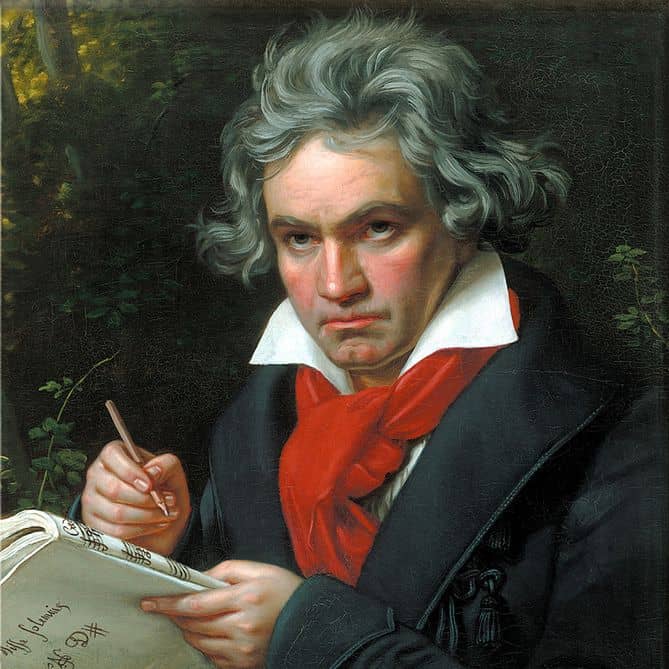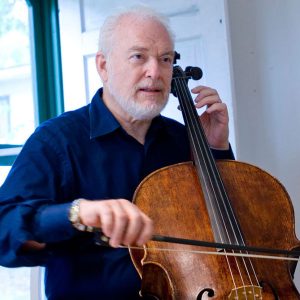
Reflections on the 17 Beethoven String Quartets: The Early Period Quartets (Part 1 of 5)
Paul Katz
The Early Period Quartets
By Paul Katz
It’s been a personal joy for me to revisit the album notes I wrote 45 years ago for the Cleveland Quartet’s recorded Beethoven Quartet Cycle on RCA Victor. The 17 quartets of Beethoven were the core of our 26-year concertizing career as we immersed ourselves in research, score study, years of exhilarating rehearsals, two recorded cycles, 30 complete cycles in the major capitals of the world, and literally thousands of Beethoven quartet performances. Musicians generally agree that there is no other music as rewarding or profound in all of western music. These masterpieces have challenged me as a musician and enriched my life -what a privileged existence!
Formed in 1969, the CQ knew only 2 Beethoven quartets for the 1970 Beethoven bi-centennial year, but we joked that we would be ready for 2020! Though the Cleveland Quartet is no longer active, I could not let this special year go by without participating in some way, and so I returned to my notes written between 1975-1980, and reduced and edited them for this series of CelloBello blogs. The original project was voluminous – 3 boxed sets of LP vinyl, with written liner notes discussing each individual quartet. I have taken about 25% of that original project and present it here in a five-part series.
No composer has expressed Humankind’s deepest emotional states as profoundly as Beethoven. There is a heartfelt depth to the musical experience, an enlightened level of consciousness, a sincerity and nobleness of concept that enriches and inspires. “Those who understand (my music) must be freed by it from all the miseries that others drag about within themselves,” Beethoven is reported to have said. Whether or not he actually uttered these words is ultimately unimportant, for generations have found in his music the noblest and purest expression of universally shared human values. Pain and suffering (which he knew better than most) are beautifully expressed to us as a necessary part of the synthesis of life. Beethoven’s contemporaries described him as unkempt, emotionally volatile, and unable to keep most friends or employees. So we sometimes hear despair and anger, even rage – but never hate – not a sarcastic, cynical or bitter note. In fact, Beethoven was constantly helping others in need, was capable of extending his hand to an adversary, was a man with a warm and generous heart who philosophically and emotionally cared deeply for all of humanity. He was a person of strong principles and integrity whose strength of character shaped the core values of his life and his music. It is why generations have been uplifted and inspired, and why we who perform his music spend a lifetime of study in our efforts to do justice to his genius.
The Three Compositional Periods of Beethoven
The 16 quartets and Grosse Fuge span Beethoven’s entire mature compositional career and more clearly than any other medium of expression (i.e., symphony, concerto or sonata) illuminate a spiritual growth that eventually was to reach a transcendent level of awareness. The 19th-century scholar Wilhelm von Lenz was the first to observe that Beethoven’s compositions fall into three distinctly different style periods. D’lndy refers to these 3 periods descriptively as “imitation, externalization and reflection”, and the six Op. 18 quartets, written between 1798-1800, are from the early period of “imitation”. While these six quartets do reflect the classical period aesthetics of emotional restraint and attention to traditional formal rules of composition, “imitation” is a bit simplistic. One already hears in these quartets some of the power and strength we will come to admire in later Beethoven. Beethoven at 28 years is certainly more robust and hardier than Mozart and even Haydn, the two musical giants of this time.
Following the completion of the six Op. 18 quartets, advancing deafness led to personal agony and contemplated suicide: “Only one thing, Art, held me back”. The ensuing middle period (including the three Op. 59 quartets, Op.74 and 95) was, as Beethoven scholar Joseph Kerman observed, “more revolutionary than evolutionary’’ and paved the way for the Romantic period of the next 100 years. Compositions took on a more highly emotional, personal form of expression, traditional classical structures were expanded and Beethoven challenged the Classic Period’s rules and norms . The late period ( Op. 127,130,131,132,135, and the Grosse Fuge. Op. 133) was one of internalization, more introspective and spiritual, reflecting 20 years of suffering and isolation due to deafness. Here is music so profound, uplifting, consoling, that it is often equated with the spirituality of a Jesus or Ghandi.
The Early Period Quartets (Op. 18 #1-6)
The Op. 18 quartets, finished before his 30th birthday, were among the final works of his early period, a time in which he viewed Haydn and Mozart as both examples to emulate and rivals to surpass. In fact, these are masterpieces worthy of standing alongside the most celebrated quartets of Mozart and Haydn and forcefully demonstrate his expressive and communicative gift, a mastery of compositional technique and the sincerity and strength of his musical personality. Classical ideals are valued, yet one often feels his passion and temperament ready to burst the bonds of self-restraint. We now know that his more intensely personal, emotional compositions, which heralded the beginning of the Romantic Age, were only a few years away.
In November of 1792, less than a year after the death of Mozart, Beethoven left his hometown of Bonn, Germany for study with Haydn in Vienna and the pursuit of a dual career of composer/virtuoso pianist. In retrospect we see that these years preceding the writing of the Op. 18 quartets were the happiest, most rewarding of the composer’s life. The irony and cruelty of the loss of his hearing was still in the future, and the musical stimulation found in Vienna, the cultural Mecca of Europe, was invigorating and engrossing. With immediate success and growing fame, his youthful ambition, confidence and pride were generally satisfied.
Pianistic “duels” were fashionable at this time, with patrons forming camps to back their favorite “artist” in competitive events usually held in private drawing rooms. Beethoven quickly established preeminence as a pianist of power, brilliance and virtuosity with a highly emotional, imaginative style (adjectives soon to be used in describing his compositions as well). One of the best- known stories relates the reaction to Beethoven of an important pianist of the time. Abbe Gelinek: “I have been requested to measure myself with a young pianist who has just arrived—and I will work him over properly,” he remarked to Carl Czerny’s father. Following his musical joust, however. Gelinek moaned. “Ah. he is not a man. he is a devil! He will play me and all of us to death.” Carl Czerny describes Beethoven in concert, “… he knew how to produce such an effect upon every hearer that frequently not an eye remained dry, while many would break out into loud sobs, for there was something wonderful in his expression in addition to the beauty and originality of his ideas and his spirited style of reading them.” It is obvious from these accounts that Beethoven had a virtuosic performing mentality—a desire to impress, to move, to reach and to affect his listeners. It is natural that we also find the same intentions in his compositions.
Beethoven was fortunate to develop an early friendship with Prince Carl Lichnowsky, who in addition to being extraordinarily wealthy (the patronage system still offered security for artists) was passionately involved and knowledgeable in music. His home, in which Beethoven lived until May 1795 and frequented for many years after that, was a meeting place for musicians of the day. including weekly Friday morning sessions of the Schuppanzigh Quartet (according to George Marek, a number of get-togethers took place from 6 to 8 a.m.!) It was in this environment that the early violin and Op. 5 cello sonatas, string trios and ultimately the Op. 18 quartets were conceived. Beethoven’s lifelong friendship with Ignaz Schuppanzigh, a marvelous violinist and a likable, rotund fellow whom the composer enjoyed referring to as “Falstaff” began at this time. In 1808 the Schuppanzigh Quartet was renamed Rasumovsky Quartet after its benefactor and it gained widespread fame for Beethoven interpretations. Devoted to the composer, the quartet provided Beethoven a quartet workshop for the rest of his life.
Although Beethoven toured much of Europe in 1795 as a pianist of great stature, as a composer he did not yet feel ready to accept a commission offered by Count Apponyi to write a string quartet—a curiously cautious attitude from the brash, already successful young composer to whom Count Waldstein had written even three years earlier, “With the help of assiduous labor you shall inherit Mozart’s spirit from Haydn’s hands.” Kerman, in “The Beethoven Quartets,” has a plausible explanation:
In so sophisticated and dense a musical environment as Vienna in the 1790s no one composed for himself in a vacuum let alone a musician as jealous of his status as Beethoven was. As a virtuoso pianist and virtuoso improviser, he easily established mastery and originality in the sonata, the variations and the concerto for piano; he “surpassed” Haydn and Mozart in a certain sense by finding a place in the sun which they did not occupy. But with the string quartet, the symphony, the mass, oratorio, and opera— here he moved into formidable competition with Haydn and Mozart in the forms they had cultivated with full responsibility and artistic intensity.
Two hundred twenty years later there can be no doubt of Beethoven’s accomplishment. The six Op. 18 quartets—written in the years 1798-1800—are universally acknowledged as among the finest of the Classic period.
Continued Tomorrow: The Middle Period Quartets (Op. 59#1-3, Op. 74, Op. 95)
Subjects: Chamber Music, Repertoire
